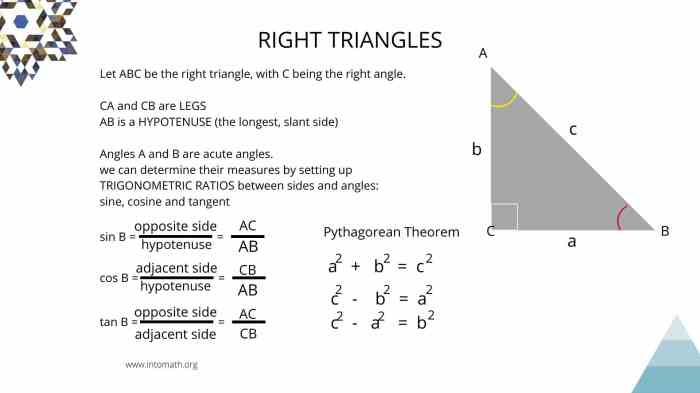Lesson 7 describe angle relationships in triangles – In the realm of geometry, angles play a pivotal role, and their relationships within triangles form the foundation of many mathematical concepts. Lesson 7: Angle Relationships in Triangles delves into the intricacies of these connections, providing a comprehensive understanding of their properties and applications.
This lesson explores the three primary types of angle relationships: complementary, supplementary, and vertical. Through detailed explanations and illustrative examples, it unravels the properties associated with each type, empowering students to analyze and solve problems involving angle relationships.
1. Types of Angle Relationships in Triangles

In geometry, the angles formed by the sides of a triangle are related to each other in specific ways. Understanding these angle relationships is essential for solving problems and understanding the properties of triangles.
There are three main types of angle relationships in triangles: complementary, supplementary, and vertical.
Complementary Angles
- Two angles are complementary if their sum is 90 degrees.
- For example, in a right triangle, the two acute angles are complementary.
Supplementary Angles
- Two angles are supplementary if their sum is 180 degrees.
- For example, the two base angles of an isosceles triangle are supplementary.
Vertical Angles
- Two angles are vertical if they are opposite each other and formed by two intersecting lines.
- Vertical angles are always congruent, meaning they have the same measure.
| Type of Angle Relationship | Definition | Properties |
|---|---|---|
| Complementary Angles | Two angles whose sum is 90 degrees |
|
| Supplementary Angles | Two angles whose sum is 180 degrees |
|
| Vertical Angles | Two angles that are opposite each other and formed by two intersecting lines |
|
2. Properties of Angle Relationships in Triangles

The properties of angle relationships in triangles can be used to solve problems and understand the geometry of triangles.
Properties of Complementary Angles
- The sum of two complementary angles is always 90 degrees.
- If two angles are complementary, then one angle is acute and the other is obtuse.
Properties of Supplementary Angles, Lesson 7 describe angle relationships in triangles
- The sum of two supplementary angles is always 180 degrees.
- If two angles are supplementary, then both angles are acute, right, or obtuse.
Properties of Vertical Angles
- Vertical angles are always congruent.
- If two angles are vertical, then they are either both acute or both obtuse.
These properties can be used to solve problems involving triangles. For example, if you know that two angles in a triangle are complementary, then you can find the measure of the third angle by subtracting the sum of the two complementary angles from 180 degrees.
3. Applications of Angle Relationships in Triangles: Lesson 7 Describe Angle Relationships In Triangles

Angle relationships in triangles have many real-world applications in fields such as architecture, engineering, and surveying.
Applications in Architecture
- Angle relationships are used to design buildings that are structurally sound and aesthetically pleasing.
- For example, the angles of the roof trusses must be carefully calculated to ensure that the roof can withstand the weight of the building and the force of the wind.
Applications in Engineering
- Angle relationships are used to design bridges, machines, and other structures that must be able to withstand forces from multiple directions.
- For example, the angles of the beams in a bridge must be carefully calculated to ensure that the bridge can withstand the weight of the traffic and the force of the wind.
Applications in Surveying
- Angle relationships are used to measure distances and angles in order to create maps and surveys.
- For example, surveyors use theodolites to measure the angles between different points in order to create a map of a property.
4. Theorems Related to Angle Relationships in Triangles

There are several theorems that are related to angle relationships in triangles. Two of the most important theorems are the Angle Bisector Theorem and the Exterior Angle Theorem.
Angle Bisector Theorem
The Angle Bisector Theorem states that the angle bisector of an angle in a triangle divides the opposite side into two segments that are proportional to the lengths of the other two sides.
AB/BC = AC/CD
where AB and AC are the lengths of the two sides of the triangle, and BC and CD are the lengths of the two segments of the opposite side created by the angle bisector.
Exterior Angle Theorem
The Exterior Angle Theorem states that the measure of an exterior angle of a triangle is equal to the sum of the measures of the two opposite interior angles.
∠ABC = ∠ACB + ∠BCA
where ∠ABC is the exterior angle and ∠ACB and ∠BCA are the two opposite interior angles.
These theorems can be used to solve problems involving triangles. For example, if you know the lengths of two sides of a triangle and the measure of the angle between them, you can use the Angle Bisector Theorem to find the lengths of the other two sides.
FAQ
What are the three main types of angle relationships in triangles?
Complementary, supplementary, and vertical angles.
How can I use angle relationships to solve problems?
By applying properties such as the sum of angles in a triangle being 180 degrees.
What are some real-world applications of angle relationships in triangles?
Architecture, engineering, and surveying.